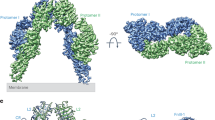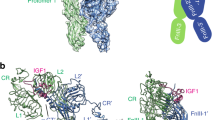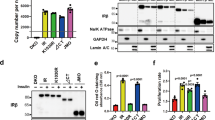Abstract
Breast tumor kinase (Brk) is a member of the Frk family of nonreceptor tyrosine kinases that is overexpressed in a high percentage of human breast tumors. The downstream substrates and effectors of Brk remain largely unidentified. In this study, we carried out immunoprecipitation and mass spectrometry experiments to identify new Brk binding partners. One interacting protein was insulin receptor substrate 4 (IRS-4), a member of the IRS family. We confirmed that Brk associates with IRS-4 in resting and insulin-like growth factor 1 (IGF-1)-stimulated HEK 293 cells. The SH3 and SH2 domains of Brk are both involved in the association. The tyrosine phosphorylation of Brk increases after stimulation with IGF-1, and in MCF-7 breast cancer cells we show that the presence of IRS-4 enhances this effect. Finally, we demonstrate that endogenous Brk and IRS-4 interact in A431 human epidermoid carcinoma cells.
This is a preview of subscription content, access via your institution
Access options
Subscribe to this journal
Receive 50 print issues and online access
$259.00 per year
only $5.18 per issue
Buy this article
- Purchase on Springer Link
- Instant access to full article PDF
Prices may be subject to local taxes which are calculated during checkout







Similar content being viewed by others
References
Barker KT, Jackson LE and Crompton MR . (1997). Oncogene, 15, 799–805.
Chen H-Y, Shen C-H, Tsai Y-T, Lin F-C, Huang Y-P and Chen R-H . (2004). Mol. Cell. Biol., 24, 10558–10572.
Derry JJ, Prins GS, Ray V and Tyner AL . (2003). Oncogene, 22, 4212–4220.
Derry JJ, Richard S, Valderrama Carvajal H, Ye X, Vasioukhin V, Cochrane AW, Chen T and Tyner AL . (2000). Mol. Cell. Biol., 20, 6114–6126.
Escribano O, Fernandez-Moreno MD, Zueco JA, Menor C, Fueyo J, Ropero RM, Diaz-Laviada I, Roman ID and Guijarro LG . (2003). Hepatology, 37, 1461–1469.
Fantin VR, Keller SR, Lienhard GE and Wang LM . (1999). Biochem. Biophys. Res. Commun., 260, 718–723.
Fantin VR, Sparling JD, Slot JW, Keller SR, Lienhard GE and Lavan BE . (1998). J. Biol. Chem., 273, 10726–10732.
Fantin VR, Wang Q, Lienhard GE and Keller SR . (2000). Am. J. Physiol. Endocrinol. Metab., 278, E127–E133.
Giovannone B, Scaldaferri ML, Federici M, Porzio O, Lauro D, Fusco A, Sbraccia P, Borboni P, Lauro R and Sesti G . (2000). Diabetes Metab. Res. Rev., 16, 434–441.
Harvey AJ and Crompton MR . (2003). Oncogene, 22, 5006–5010.
Harvey AJ and Crompton MR . (2004). Anticancer Drugs, 15, 107–111.
Joyal JL, Annan RS, Ho YD, Huddleston ME, Carr SA, Hart MJ and Sacks DB . (1997). J. Biol. Chem., 272, 15419–15425.
Kamalati T, Jolin HE, Fry MJ and Crompton MR . (2000). Oncogene, 19, 5471–5476.
Kamalati T, Jolin HE, Mitchell PJ, Barker KT, Jackson LE, Dean CJ, Page MJ, Gusterson BA and Crompton MR . (1996). J. Biol. Chem., 271, 30956–30963.
Karas M, Koval AP, Zick Y and LeRoith D . (2001). Endocrinology, 142, 1835–1840.
Koval AP, Karas M, Zick Y and LeRoith D . (1998). J. Biol. Chem., 273, 14780–14787.
Lavan BE, Fantin VR, Chang ET, Lane WS, Keller SR and Lienhard GE . (1997). J. Biol. Chem., 272, 21403–21407.
Lingohr MK, Dickson LM, Wrede CE, Briaud I, McCuaig JF, Myers Jr MG and Rhodes CJ . (2003). Mol. Cell Endocrinol., 209, 17–31.
Llor X, Serfas MS, Bie W, Vasioukhin V, Polonskaia M, Derry J, Abbott CM and Tyner AL . (1999). Clin. Cancer Res., 5, 1767–1777.
McCormack AL, Schieltz DM, Goode B, Yang S, Barnes G, Drubin D and Yates III JR . (1997). Anal. Chem., 69, 767–776.
Mitchell PJ, Barker KT, Martindale JE, Kamalati T, Lowe PN, Page MJ, Gusterson BA and Crompton MR . (1994). Oncogene, 9, 2383–2390.
Mitchell PJ, Sara EA and Crompton MR . (2000). Oncogene, 19, 4273–4282.
Perkins DN, Pappin DJ, Creasy DM and Cottrell JS . (1999). Electrophoresis, 20, 3551–3567.
Qiu H and Miller WT . (2002). J. Biol. Chem., 277, 34634–34641.
Qiu H and Miller WT . (2004). Oncogene, 23, 2216–2223.
Qu BH, Karas M, Koval A and LeRoith D . (1999). J. Biol. Chem., 274, 31179–31184.
Sesti G . (2000). Pharmacogenomics, 1, 343–357.
Sesti G, Federici M, Hribal ML, Lauro D, Sbraccia P and Lauro R . (2001). FASEB J., 15, 2099–2111.
Sun XJ, Pons S, Wang LM, Zhang Y, Yenush L, Burks D, Myers Jr MG, Glasheen E, Copeland NG, Jenkins NA, Pierce JH and White MF . (1997). Mol. Endocrinol., 11, 251–262.
Tseng YH, Kriauciunas KM, Kokkotou E and Kahn CR . (2004). Mol. Cell. Biol., 24, 1918–1929.
Uchida T, Myers Jr MG and White MF . (2000). Mol. Cell Biol., 20, 126–138.
Vasioukhin V, Serfas MS, Siyanova EY, Polonskaia M, Costigan VJ, Liu B, Thomason A and Tyner AL . (1995). Oncogene, 10, 349–357.
Vasioukhin V and Tyner AL . (1997). Proc. Natl. Acad. Sci. USA, 94, 14477–14482.
Zhang P, Ostrander JH, Faivre EJ, Olsen A, Fitzsimmons D and Lange CA . (2005). J. Biol. Chem., 280, 1982–1991.
Acknowledgements
This work was supported by a grant from the NIH to WTM (CA28146).
Author information
Authors and Affiliations
Corresponding author
Rights and permissions
About this article
Cite this article
Qiu, H., Zappacosta, F., Su, W. et al. Interaction between Brk kinase and insulin receptor substrate-4. Oncogene 24, 5656–5664 (2005). https://doi.org/10.1038/sj.onc.1208721
Received:
Revised:
Accepted:
Published:
Issue Date:
DOI: https://doi.org/10.1038/sj.onc.1208721
Keywords
This article is cited by
-
Pharmacological targeting PTK6 inhibits the JAK2/STAT3 sustained stemness and reverses chemoresistance of colorectal cancer
Journal of Experimental & Clinical Cancer Research (2021)
-
IRS4 induces mammary tumorigenesis and confers resistance to HER2-targeted therapy through constitutive PI3K/AKT-pathway hyperactivation
Nature Communications (2016)



